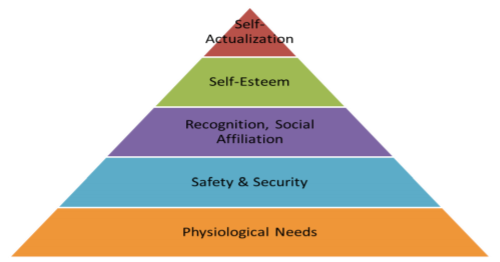2.5: Company Culture and Employee Needs
- Page ID
- 39481
How to Change Culture in a Company
Changing the culture within a company can be a long, daunting process. Even in the best of circumstances, the change will not happen overnight. Quality professionals are limited in their ability to alter the culture of a manufacturing organization. For real change to occur, everyone in the organization must be motivated to change. A successful company takes care of its employees' basic needs by cultivating a culture of respect, fairness, and rewards for a job well done. These key ingredients are powerful motivators that inspire employees to work hard and conscientiously for the company.
Maslow’s Hierarchy of Needs
Maslow’s Hierarchy of Needs is a psychology approach that was proposed by Abraham Maslow and first expressed in his paper "A Theory of Human Motivation," published in 1943 and was more fully formulated in 1954 in his book "Motivation and Personality." Very put, the further up the pyramid an employee can go, the more connected that employee feels to that company. Although Maslow himself never used a pyramid to describe this theory, it is still a good way to pictorially represent the message, which is that drive and motivation are highly correlated when describing human behavior.

Maslow’s Hierarchy is a popular approach to understanding and approaching change management. To affect change management must understand where employees are in Maslow’s hierarchy, identify their needs, and facilitate and promote their involvement to help them move up the hierarchy. The original hierarchy states that a lower level must be completely satisfied and fulfilled before moving onto a higher pursuit. However, today, scholars prefer to think of these levels as continuously overlapping each other. This means that the lower levels may take precedence back over the other levels at any point in time. Another important point to note is that people’s perceptions are as important as their reality, and what people value differs from person to person. Learn more here about Maslow’s Extended Hierarchy of Needs motivational theory.


